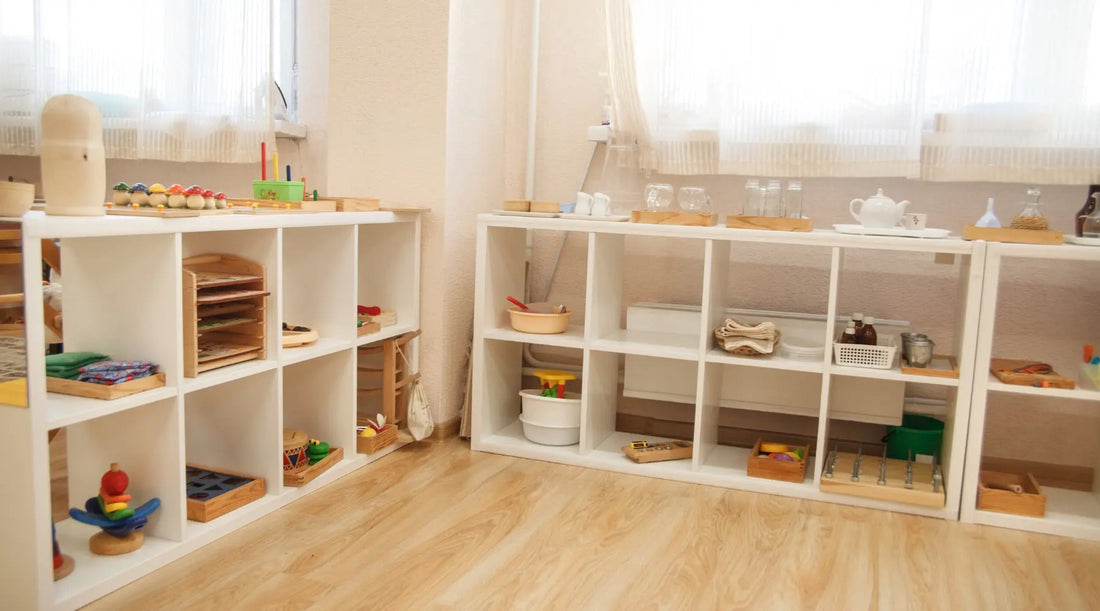
Top 10 Montessori Activities to Encourage Bilingualism in Toddlers
Learning a second language from a young age is a valuable opportunity. Montessori teaching, which is based on exploration, manipulation, and autonomy, offers an excellent approach to introducing bilingualism in a natural way.
Here are 10 Montessori activities to stimulate language and encourage your child to learn a second language.
1. Bilingual vocabulary baskets
From 6 months
This sensory activity allows the child to associate words with concrete objects, thus facilitating the memorization of vocabulary.
• Prepare a small basket with everyday objects (spoon, ball, car, plastic animal, etc.).
• Say the name of each object in both languages. Ex.: “This is a spoon – C’est une cuillère.”
• Let the child explore freely and repeat the words when he touches an object.
2. Bilingual picture cards
From 6 months
Picture cards help children make the connection between a word, an image and a sound, while developing their visual memory.
• Use cards with pictures of animals, objects, fruits, etc.
• Match each card to a word in both languages.
• Ask questions: “Where is the cat?” / “Show me the cat.”
👀 Bilingual picture cards are included in our Curious Koala kit , suitable for babies from 6 to 9 months.
3. Interactive bilingual books
From birth
Reading a story in two languages helps the child understand that the same concept can exist in different linguistic forms.
• Read each page in one language, then in the other.
• Ask questions in both languages with reference to the story.
🐨 What if we told you that each of our boxes , inspired by the Montessori method, contains a bilingual book on the story of Miko the Koala! 🤭
4. Singing and nursery rhymes in two languages
From birth
Melodies and rhymes help with memorization and make learning a language fun.
• Sing nursery rhymes in French and English for example (Une Souris Verte, Twinkle Twinkle Little Star…).
• Associate actions with words to reinforce understanding.
• Repeat the same songs regularly to anchor vocabulary.
5. The “I Spy Game”
From 2 years old
This game encourages observation and learning vocabulary in context.
• Point to an object and say, “I see something red… Can you find something red?”
• Let the child point to the object and name it in both languages.
6. Sensory activities in two languages
From birth
Associating a word with a sensation reinforces learning.
• During a sensory activity (play dough, fabrics, sand, water, etc.), describe what the child is doing: “The water is cold – L’eau est froide” / “This fabric is soft – This fabric is soft”
7. Daily routine in bilingual
From birth
Children learn best when they hear a language in real-life situations.
• Match English words to each everyday action:
• “Let's brush your teeth – We brush our teeth.”
• “Time to put on your shoes – We put on the shoes.”
8. The bilingual treasure hunt
From 2 years old
This game encourages the child to associate a word with an object and to interact in both languages.
• Say a command in English: “Find something yellow!”
• Let the child look for an object and repeat in French: “You found a yellow ball!”
9. The Montessori Mystery Bag
From 2 years old
The child explores with his hands and learns new words through touch.
• Fill an opaque bag with objects.
• Ask the child to guess what he is touching and name it:
• “It's soft – It's soft.”
• “It’s round.”
10. Bilingual role-playing games
From 3 years old
Role-playing games stimulate the imagination and introduce simple dialogue.
• Play shopkeeper, doctor or cook using everyday phrases:
• “Can I have an apple, please?”
• “The baby is sleeping – The baby is sleeping.”
Introducing bilingualism through Montessori teaching allows you to naturally enrich your child's vocabulary while respecting their learning pace. These simple and fun activities will help them integrate a second language into their daily lives, effortlessly and without frustration.
Even if you're not fluent in the language, the important thing is to create regular and positive exposure to it. With the right tools, like the Noor & Koala bilingual educational kits , you can turn every moment of everyday life into a rewarding learning opportunity!
